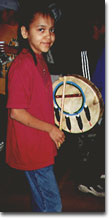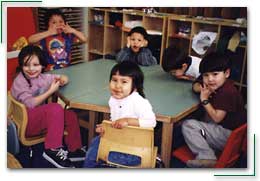VOCATIONAL OUTCOMES ...Supporting community-identified goalsIn the seven First Nations Partnership Programs that participated in the evaluation, the training supported community-identified goals for expanded service delivery with the twofold purpose of providing safe, stimulating day care for children and enabling parents to pursue education and employment.
In the five Cree and four Dene communities represented by the Meadow Lake Tribal Council, graduates started day cares and other child and family services at their home reserves in remote parts of northern Saskatchewan. Some took up leadership roles in Health and Social Development planning within the offices of the Meadow Lake Tribal Council. One joined the staff of a safe home for women, where she introduced residential programming for children. The Cowichan Tribes partnership was delivered in a semi-urban environment and was the only program where classes were held on a college campus on reserve land. Graduates accessed a wide variety of vocational options, including child care, parent support, probation services, and college student services. Eight of the original 22 students laddered on to third and fourth years of university study towards a degree, mainly in education. |
|
At Onion Lake First Nation, with a population of approximately 1700, half of the program graduates were hired as staff at child care programs in their villages, and others became assistants atthe community school. Seven graduates continued with First Nations Partnership Programs in a pilot project that enables them to work towards a degree in Child and Youth Care, using a mix of traditional correspondence course packages and group support structures. Evidence collected to date indicates that the traditional packages are problematic and that a GCM 3rd and 4th year is the preferred option, if funds can be located for their development. Program graduates in the partnership with Nzen'man' Child and FamilyServices are involved in a variety of centred-based and family day careprograms, and after-school care, as well as mobile programs reaching out to children and families in remote rural areas. Mid-way through the Tl'azt'en Nation partnership, for example, students became involved in planning and naming the community's first day care centre; negotiating contracts with a local cabinet making training program to provide furniture and toys for the facility; and developing operational policies and procedures. They created curriculum activities that are now being used to teach young children their traditional Carrier language and to promote positive self- identity as Tl'azt'enne people. Some of the students' supervised practica training took place at the Sumyaz (meaning 'Little Star') facility, and program graduates subsequently took on the operation of the day care with the support of the community. All of the program graduates at Tl'azt'en Nation found employment at the new Sumyaz Daycare and Aboriginal Head Start program on their reserve that they had helped to plan and implement.
A range of new programs were started and staffed by graduates from the six villages that comprised the partnership with Treaty 8 Tribal Association. These include the 'Cree-ative Daycare' at Salteau reserve, emphasizing Cree language learning in the early years, and English literacy programs to help parents prepare their children for school. At Mount Currie First Nation, the training program ended just one day prior to the official opening of a multiplex that houses two new programs: the Tsipalin (meaning 'Baby Basket') program for infants and toddlers, and the Sqwalx (meaning 'Young Eagle') pre-school program. These services are staffed almost entirely by program graduates, who have created opportunities for young children to learn the traditional Lil'wat language, songs, games, dances, drumming and ways of telling and listening to stories of their people and their natural environment. While most of the program graduates are staffing the new preschool and infant-toddler programs, one graduate works at a preschool in the nearby non-native town; two graduates are teacher assistants at the community school on reserve; and another graduate is a child care provider for a child with special needs.
| |||


